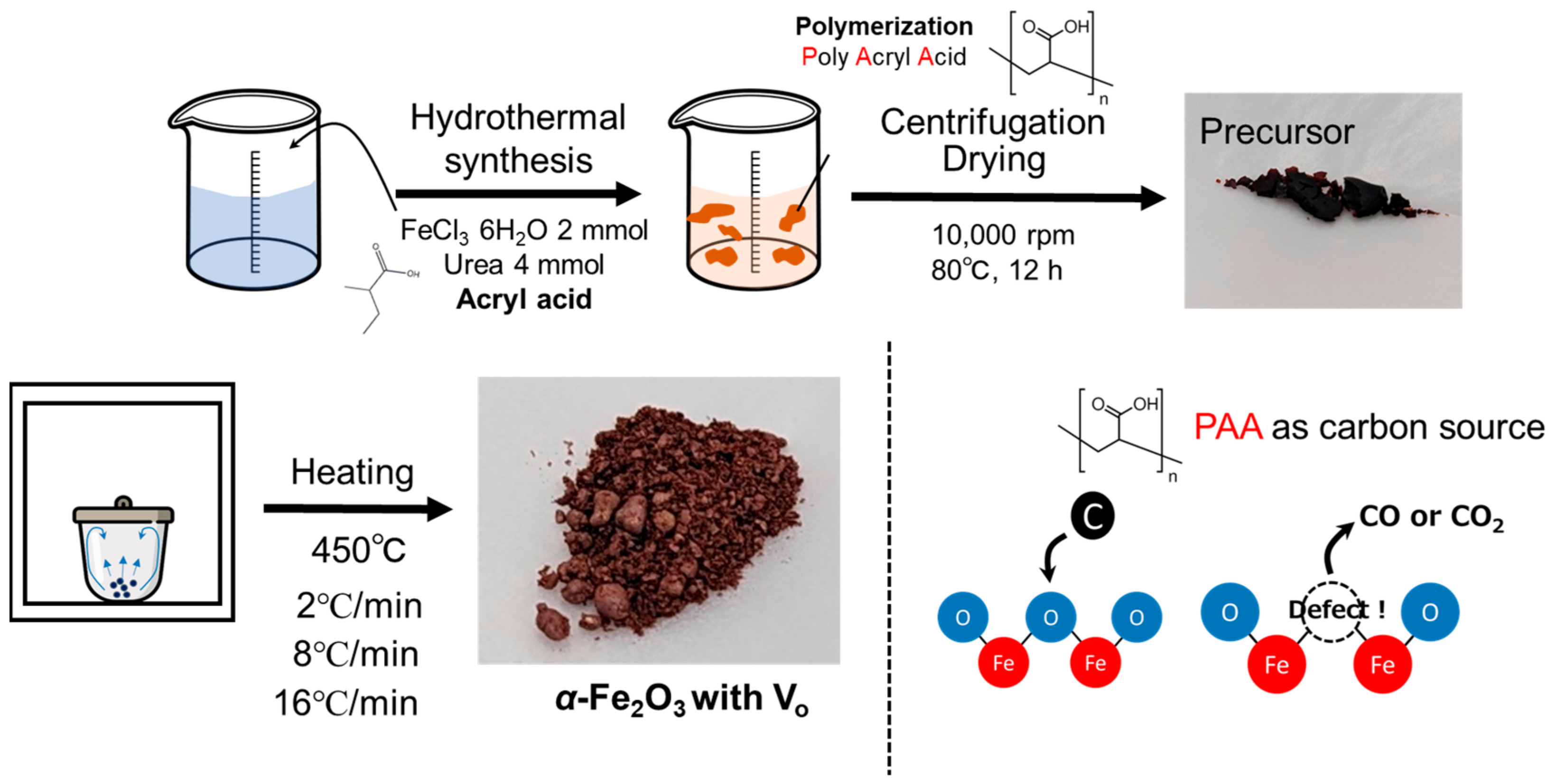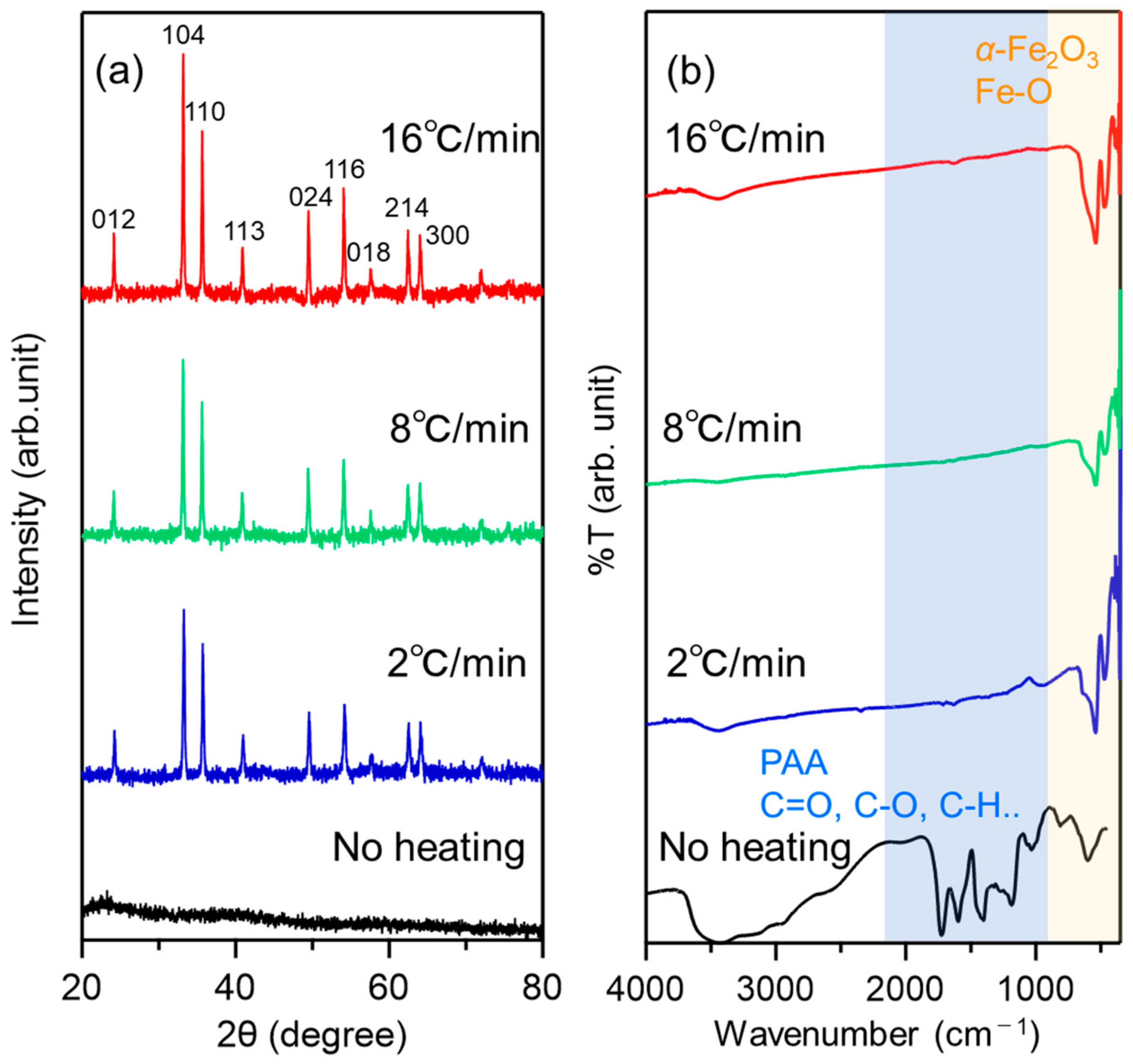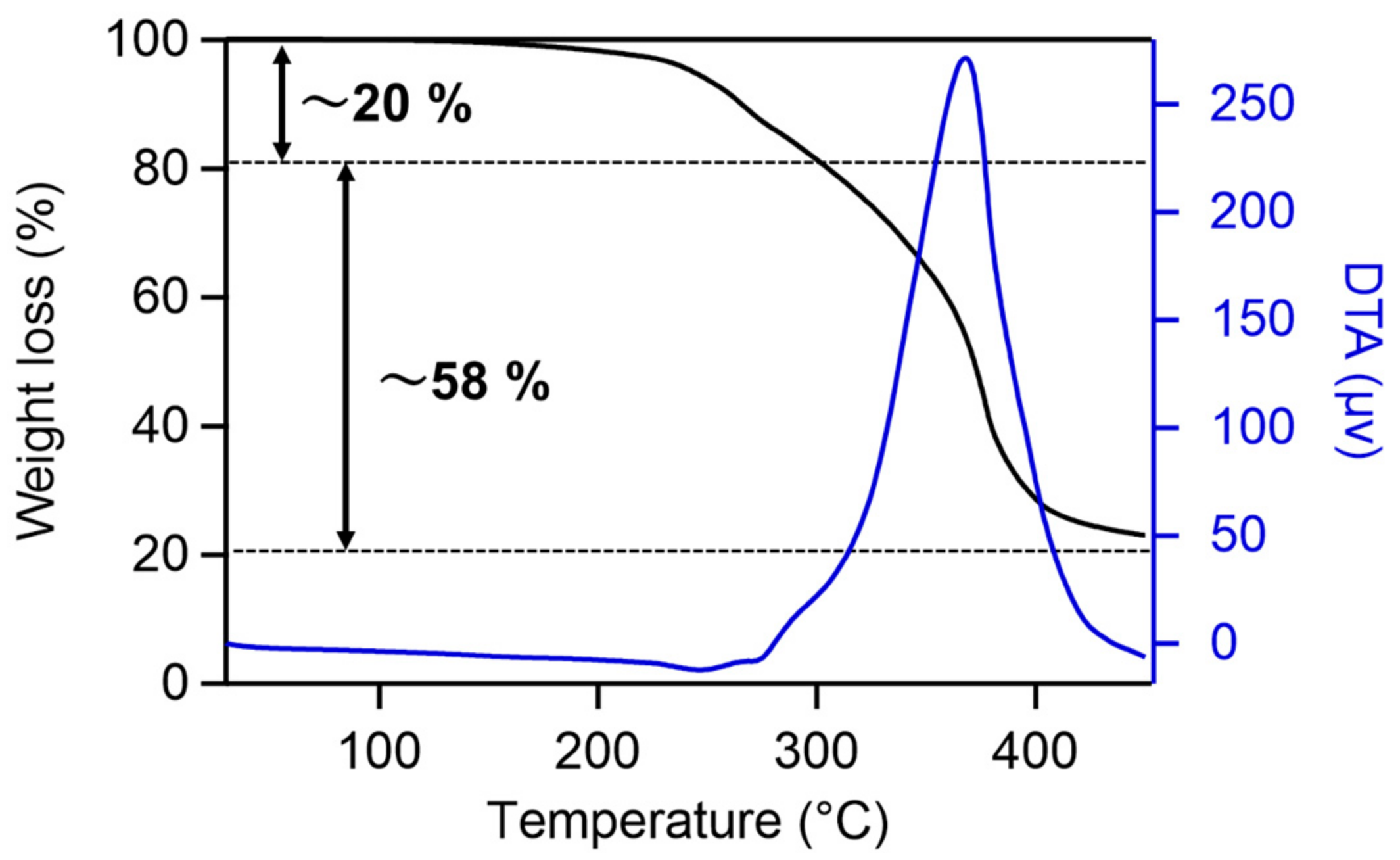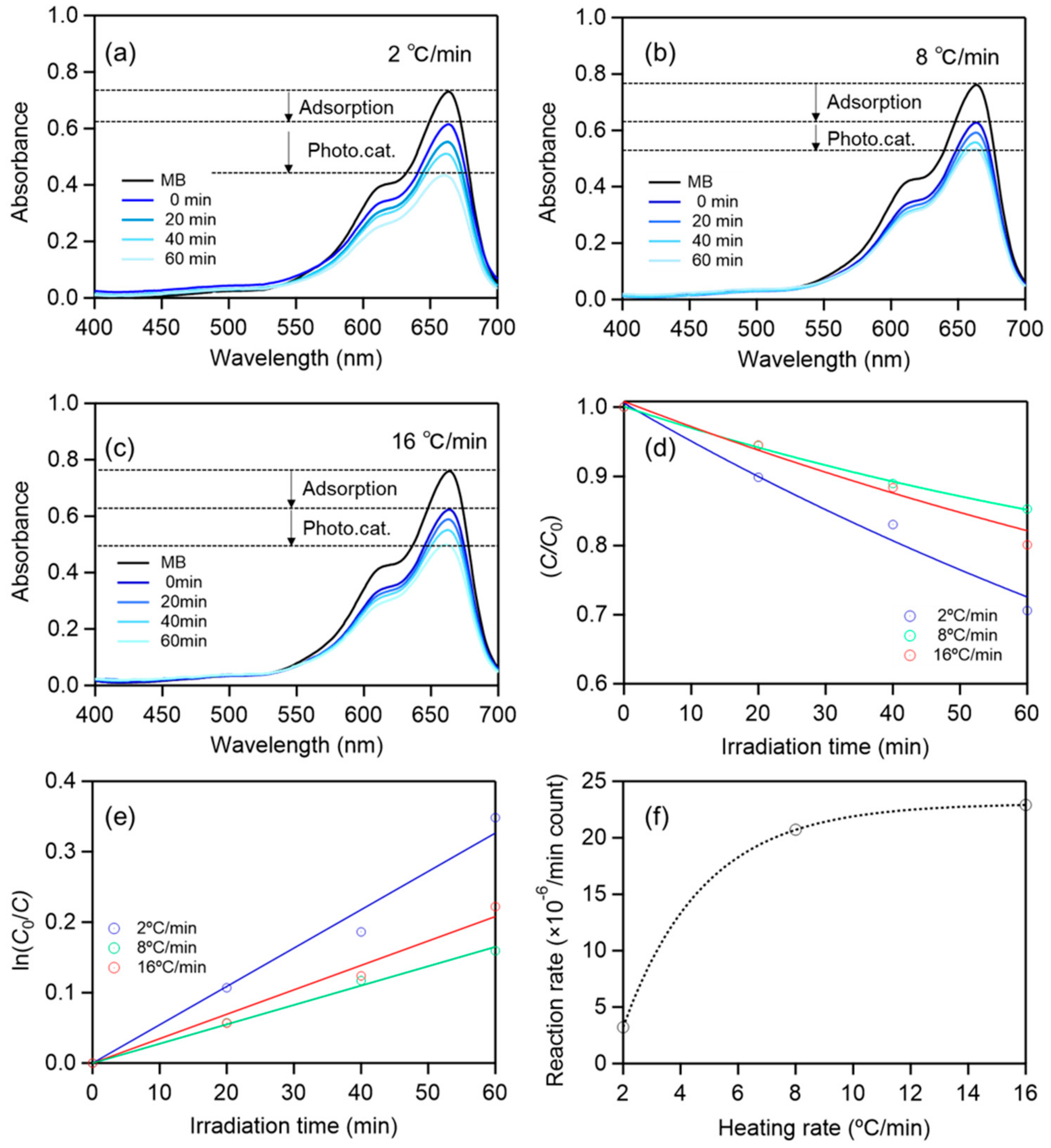Hematite (α-Fe2O3) with Oxygen Defects: The Effect of Heating Rate for Photocatalytic Performance
Abstract
:1. Introduction
2. Materials and Methods
2.1. Preparation of Hematite NPs
- CO(NH2)2 + H2O → 2NH3 + CO2,
- NH3 + H2O → NH4+ + OH−
- FeCl3 + 3OH− → Fe(OH)3 + 3Cl−
- Fe(OH)3 → β-FeOOH + H2O
- 2β-FeOOH → α-Fe2O3 + H2O
- Direct reduction: Fe2O3 + 3C → 2Fe + 3CO
- Indirect reduction: Fe2O3 + 3CO → 2Fe + 3CO2
- Carbon loss reaction: C + CO2 → 2CO
2.2. Evaluation of Hematite Nanoparticles
2.3. Evaluation of Photocatalytic Performance of Hematite with Vo
3. Results
4. Discussion
5. Conclusions
Supplementary Materials
Author Contributions
Funding
Institutional Review Board Statement
Informed Consent Statement
Data Availability Statement
Conflicts of Interest
References
- Mishra, M.; Chun, D.-M. α-Fe2O3 as a Photocatalytic Material: A Review. Appl. Catal. A 2015, 498, 126–141. [Google Scholar] [CrossRef]
- Hitam, C.N.C.; Jalil, A.A. A Review on Exploration of Fe2O3 Photocatalyst towards Degradation of Dyes and Organic Contaminants. J. Environ. Manag. 2020, 258, 110050. [Google Scholar] [CrossRef]
- Tamirat, A.G.; Rick, J.; Dubale, A.A.; Su, W.-N.; Hwang, B.-J. Using Hematite for Photoelectrochemical Water Splitting: A Review of Current Progress and Challenges. Nanoscale Horiz. 2016, 1, 243–267. [Google Scholar] [CrossRef]
- Yang, T.-Y.; Kang, H.-Y.; Sim, U.; Lee, Y.-J.; Lee, J.-H.; Koo, B.; Nam, K.T.; Joo, Y.-C. A New Hematite Photoanode Doping Strategy for Solar Water Splitting: Oxygen Vacancy Generation. Phys. Chem. Chem. Phys. 2013, 15, 2117–2124. [Google Scholar] [CrossRef] [PubMed]
- Ma, J.; Long, R.; Liu, D.; Low, J.; Xiong, Y. Defect Engineering in Photocatalytic Methane Conversion. Small Struct. 2022, 3, 2100147. [Google Scholar] [CrossRef]
- Chen, S.; Wang, J.; Zhou, M.; Zhu, H.; Zhang, Y.; Li, J.; Bai, J.; Xia, L.; Xu, Q.; Zhou, B. Effect of Oxygen–Iron Composition on Charge Transport and Interface Reaction in Hematite. ACS Catal. 2020, 10, 2413–2418. [Google Scholar] [CrossRef]
- Da Silva Alvim, R.; Ribeiro, F.N.; Dalpian, G.M. Iron and Oxygen Vacancies at the Hematite Surface: Pristine Case and with a Chlorine Adatom. Phys. Chem. Chem. Phys. 2020, 22, 25380–25389. [Google Scholar] [CrossRef]
- Wang, Z.; Lin, R.; Huo, Y.; Li, H.; Wang, L. Formation, Detection, and Function of Oxygen Vacancy in Metal Oxides for Solar Energy Conversion. Adv. Funct. Mater. 2022, 32, 2109503. [Google Scholar] [CrossRef]
- Liu, Y.; Smith, R.D.L. Differentiating Defects and Their Influence on Hematite Photoanodes Using X-Ray Absorption Spectroscopy and Raman Microscopy. ACS Appl. Mater. Interfaces 2022, 14, 6615–6624. [Google Scholar] [CrossRef] [PubMed]
- Li, Z.; Wu, J.; Liao, L.; He, X.; Huang, B.; Zhang, S.; Wei, Y.; Wang, S.; Zhou, W. Surface Engineering of Hematite Nanorods Photoanode towards Optimized Photoelectrochemical Water Splitting. J. Colloid Interface Sci. 2022, 626, 879–888. [Google Scholar] [CrossRef] [PubMed]
- Gao, R.; Pan, L.; Li, Z.; Shi, C.; Yao, Y.; Zhang, X.; Zou, J.-J. Engineering Facets and Oxygen Vacancies over Hematite Single Crystal for Intensified Electrocatalytic H2O2 Production. Adv. Funct. Mater. 2020, 30, 1910539. [Google Scholar] [CrossRef]
- Zhu, C.; Li, C.; Zheng, M.; Delaunay, J.-J. Plasma-Induced Oxygen Vacancies in Ultrathin Hematite Nanoflakes Promoting Photoelectrochemical Water Oxidation. ACS Appl. Mater. Interfaces 2015, 7, 22355–22363. [Google Scholar] [CrossRef]
- Sakamoto, M.; Akashi, K.; Hotta, R.; Hino, T.; Hirazawa, H. High Photothermal Conversion of Ball-Milled Titanium Nitride Nanoparticles: Evaluation of Size and Amorphous Effect. ACS Appl. Eng. Mater. 2023, 1, 287–294. [Google Scholar] [CrossRef]
- Noh, M.F.M.; Ullah, H.; Arzaee, N.A.; Halim, A.A.; Rahim, M.A.F.; Mohamed, N.A.; Safaei, J.; Nasir, S.N.F.; Wang, G.; Teridi, M.A.M. Rapid Fabrication of Oxygen Defective α-Fe2O3(110) for Enhanced Photoelectrochemical Activities. Dalton Trans. 2020, 49, 12037–12048. [Google Scholar]
- Zhang, L.; Xue, X.; Guo, T.; Bi, L.; Hu, T.; Tan, L.; Zhang, X.; Jiang, J.; Hong, K.; Zhang, Q. Creation of Oxygen Vacancies to Activate Fe2O3 Photoanode by Simple Solvothermal Method for Highly Efficient Photoelectrochemical Water Oxidation. Int. J. Hydrogen Energy 2021, 46, 12897–12905. [Google Scholar] [CrossRef]
- Zeng, P.; Zhao, Y.; Lin, Y.; Wang, X.; Li, J.; Wang, W.; Fang, Z. Enhancement of Electrochemical Performance by the Oxygen Vacancies in Hematite as Anode Material for Lithium-Ion Batteries. Nanoscale Res. Lett. 2017, 12, 13. [Google Scholar] [CrossRef] [PubMed]
- Chen, J.; Huang, W.; Pan, S.; Liu, R. A Facile Urea-Hydrolysis Calcination Process for the Preparation of α -Fe2O3 Nanoparticles and α -Fe2O3 Nanorods and Their Fabrication Mechanisms. AIP Adv. 2020, 10, 025028. [Google Scholar] [CrossRef]
- Yang, J.; Mori, T.; Kuwabara, M. Mechanism of Carbothermic Reduction of Hematite in Hematite–carbon Composite Pellets. ISIJ Int. 2007, 47, 1394–1400. [Google Scholar] [CrossRef]
- Tran, H.D.; Nguyen, D.Q.; Do, P.T.; Tran, U.N.P. Kinetics of Photocatalytic Degradation of Organic Compounds: A Mini-Review and New Approach. RSC Adv. 2023, 13, 16915–16925. [Google Scholar] [CrossRef]
- Wang, Z.; Mao, X.; Chen, P.; Xiao, M.; Monny, S.A.; Wang, S.; Konarova, M.; Du, A.; Wang, L. Understanding the Roles of Oxygen Vacancies in Hematite-Based Photoelectrochemical Processes. Angew. Chem. Int. Ed. Engl. 2019, 58, 1030–1034. [Google Scholar] [CrossRef]
- Jin, H.; Song, T.; Paik, U.; Qiao, S.-Z. Metastable Two-Dimensional Materials for Electrocatalytic Energy Conversions. Acc. Mater. Res. 2021, 2, 559–573. [Google Scholar] [CrossRef]
- Heidari, A.; Moghimi, H.; Rashidiani, J.; Taheri, R.A. Molecular Development of Silver Nanoparticles-Loaded Poly Acrylic Acid Hydrogel as a Catalyst for Dye Degradation. Phys. Chem. Res. 2018, 6, 857–869. [Google Scholar]
- Theerthagiri, J.; Senthil, R.A.; Priya, A.; Madhavan, J.; Michael, R.J.V.; Ashokkumar, M. Photocatalytic and Photoelectrochemical Studies of Visible-Light Active α-Fe2O3–g-C3N4 Nanocomposites. RSC Adv. 2014, 4, 38222–38229. [Google Scholar] [CrossRef]
- Kusior, A.; Michalec, K.; Jelen, P.; Radecka, M. Shaped Fe2O3 Nanoparticles—Synthesis and Enhanced Photocatalytic Degradation towards RhB. Appl. Surf. Sci. 2019, 476, 342–352. [Google Scholar] [CrossRef]
- Mizuno, S.; Yao, H. On the Electronic Transitions of α-Fe2O3 Hematite Nanoparticles with Different Size and Morphology: Analysis by Simultaneous Deconvolution of UV–vis Absorption and MCD Spectra. J. Magn. Magn. Mater. 2021, 517, 167389. [Google Scholar] [CrossRef]







Disclaimer/Publisher’s Note: The statements, opinions and data contained in all publications are solely those of the individual author(s) and contributor(s) and not of MDPI and/or the editor(s). MDPI and/or the editor(s) disclaim responsibility for any injury to people or property resulting from any ideas, methods, instructions or products referred to in the content. |
© 2024 by the authors. Licensee MDPI, Basel, Switzerland. This article is an open access article distributed under the terms and conditions of the Creative Commons Attribution (CC BY) license (https://creativecommons.org/licenses/by/4.0/).
Share and Cite
Sakamoto, M.; Fujita, R.; Nishikawa, M.; Hirazawa, H.; Ueno, Y.; Yamamoto, M.; Takaoka, S. Hematite (α-Fe2O3) with Oxygen Defects: The Effect of Heating Rate for Photocatalytic Performance. Materials 2024, 17, 395. https://doi.org/10.3390/ma17020395
Sakamoto M, Fujita R, Nishikawa M, Hirazawa H, Ueno Y, Yamamoto M, Takaoka S. Hematite (α-Fe2O3) with Oxygen Defects: The Effect of Heating Rate for Photocatalytic Performance. Materials. 2024; 17(2):395. https://doi.org/10.3390/ma17020395
Chicago/Turabian StyleSakamoto, Masanori, Ryoga Fujita, Masami Nishikawa, Hideyuki Hirazawa, Yuichi Ueno, Manami Yamamoto, and Suzu Takaoka. 2024. "Hematite (α-Fe2O3) with Oxygen Defects: The Effect of Heating Rate for Photocatalytic Performance" Materials 17, no. 2: 395. https://doi.org/10.3390/ma17020395





